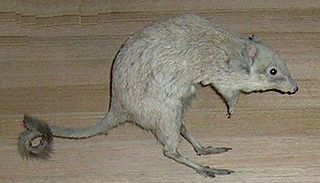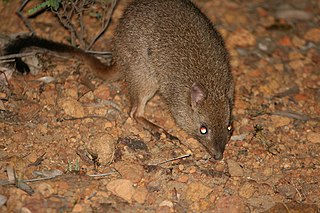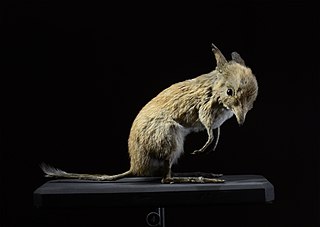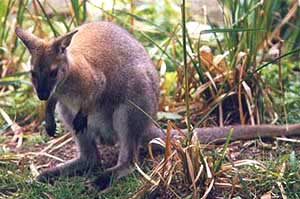
Marsupials are a diverse group of mammals belonging to the infraclass Marsupialia. They are primarily found in Australasia, Wallacea, and the Americas. One of the defining features of marsupials is their unique reproductive strategy, where the young are born in a relatively undeveloped state and then nurtured within a pouch.

Diprotodontia is the largest extant order of marsupials, with about 155 species, including the kangaroos, wallabies, possums, koala, wombats, and many others. Extinct diprotodonts include the hippopotamus-sized Diprotodon, and Thylacoleo, the so-called "marsupial lion".

The broad-faced potoroo is an extinct potoroid marsupial that was found in southwestern Australia. The first specimen was collected in 1839, and described by John Gould in 1844. Only a small number of specimens have been collected since. The last live capture was in 1875. Subfossil remains indicate that it had an extensive distribution around the semiarid coastal districts of Southwest Australia.

Potoroidae is a family of marsupials, small Australian animals known as bettongs, potoroos, and rat-kangaroos. All are rabbit-sized, brown, jumping marsupials and resemble a large rodent or a very small wallaby.

The bridled nail-tail wallaby, also known as the bridled nail-tailed wallaby, bridled nailtail wallaby, bridled wallaby, merrin, and flashjack, is a vulnerable species of macropod. It is a small wallaby found in three isolated areas in Queensland, Australia, and whose population is declining. In early 2019 the total population of the species was estimated to be fewer than 500 mature individuals in the wild and 2285 in captivity.

The woylie or brush-tailed bettong is a small, critically endangered mammal native to forests and shrubland of Australia. A member of the rat-kangaroo family (Potoroidae), it moves by hopping and is active at night, digging for fungi to eat. It is also a marsupial and carries its young in a pouch. Once widespread, the woylie mostly died out from habitat loss and introduced predators such as foxes. It is currently restricted to two small areas in Western Australia. There were two subspecies: B. p. ogilbyi in the west, and the now-extinct B. p. penicillata in the southeast.

Chaeropus, known as the pig-footed bandicoots, is a genus of small marsupials that became extinct during the 20th century. They were the only members of the family Chaeropodidae in order Peramelemorphia, with unusually thin legs, yet were able to move rapidly. Two recognised species inhabited dense vegetation on the arid and semiarid plains of Australia. The genus' distribution range was later reduced to an inland desert region, where it was last recorded in the 1950s; it is now presumed extinct.

The eastern bettong, also known as the southern or Tasmanian bettong, is a small, hopping, rat-like mammal native to grassy forests of southeastern Australia and Tasmania. A member of the rat-kangaroo family (Potoroidae), it is active at night and feeds on fungi and plant roots. Like most marsupials, it carries its young in a pouch. The eastern bettong is under pressure by introduced predators and habitat loss. The subspecies on mainland Australia is extinct, but populations of the Tasmanian subspecies have been reintroduced there.

The musky rat-kangaroo is a small marsupial found only in the rainforests of northeastern Australia. First described in the later 19th century, the only other species are known from fossil specimens. They are similar in appearance to potoroos and bettongs, but are not as closely related. Their omnivorous diet is known to include materials such as fruit and fungi, as well as small animals such as insects and other invertebrates.

The long-nosed potoroo is a small, hopping mammal native to forests and shrubland of southeastern Australia and Tasmania. A member of the potoroo and bettong family (Potoroidae), it lives alone and digs at night for fungi, roots, or small insects. It is also a marsupial and carries its young in a pouch. The long-nosed potoroo is threatened by habitat loss and introduced species such as cats or foxes. There are two subspecies: P. t. tridactylus on mainland Australia, and P. t. apicalis on Tasmania, with lighter fur.

The fat-tailed dunnart is a species of mouse-like marsupial of the Dasyuridae, the family that includes the little red kaluta, quolls, and the Tasmanian devil.

Gilbert's potoroo or ngilkat is Australia's most endangered marsupial, the rarest marsupial in the world, and one of the world's rarest critically endangered mammals, found in south-western Western Australia. It is a small nocturnal macropod that lives in small groups.

Potoroo is a common name for species of Potorous, a genus of smaller marsupials. They are allied to the Macropodiformes, the suborder of kangaroo, wallaby, and other rat-kangaroo genera. All three extant species are threatened by ecological changes since the colonisation of Australia, especially the long-footed potoroo Potorous longipes (endangered) and P. gilbertii. The broad-faced potoroo P. platyops disappeared after its first description in the 19th century. The main threats are predation by introduced species and habitat loss.

The Macropodiformes, also known as macropods, are one of the three suborders of the large marsupial order Diprotodontia. They may in fact be nested within one of the suborders, Phalangeriformes. Kangaroos, wallabies and allies, bettongs, potoroos and rat kangaroos are all members of this suborder.

The boodie, also known as the burrowing bettong or Lesueur's rat-kangaroo, is a small, furry, rat-like mammal native to Australia. Once common throughout the continent, it is now restricted to a few coastal islands. A member of the rat-kangaroo family (Potoroidae), it lives in burrows and is active at night when it forages for fungi, roots, and other plant matter. It is about the size of a rabbit and, like most marsupials, carries its young in a pouch.
The long-footed potoroo is a small marsupial found in southeastern Australia, restricted to an area around the coastal border between New South Wales and Victoria. It was first recorded in 1967 when an adult male was caught in a dog trap in the forest southwest of Bonang, Victoria. It is classified as vulnerable.

The rufous rat-kangaroo or rufous bettong is a small, jumping, rat-like marsupial native to eastern Australia. It is the only species in the genus Aepyprymnus. The largest member of the potoroo/bettong family (Potoroidae), it is about the size of a rabbit. The rufous rat-kangaroo is active at night when it digs for plant roots and fungi, and like other marsupials it carries its young in a pouch. Though its range is reduced, the population is healthy and stable.

Bettongs, species of the genus Bettongia, are potoroine marsupials once common in Australia. They are important ecosystem engineers displaced during the colonisation of the continent, and are vulnerable to threatening factors such as altered fire regimes, land clearing, pastoralism and introduced predatory species such as the fox and cat.






















